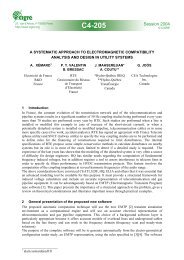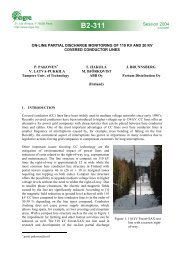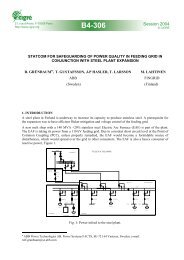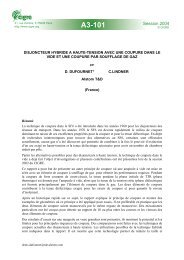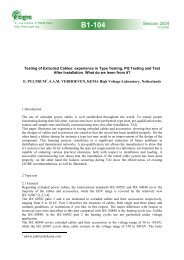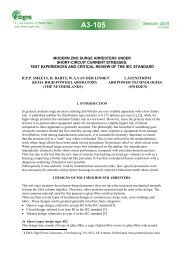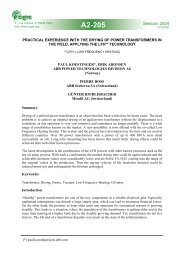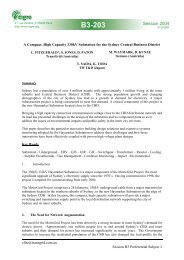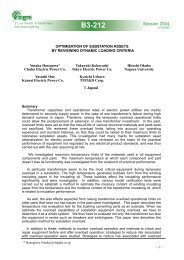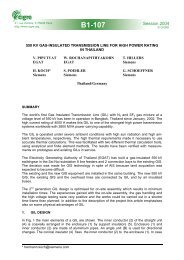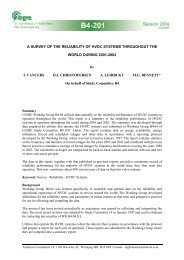Testing and loss measurement of HV shell-type shunt-reactors at ...
Testing and loss measurement of HV shell-type shunt-reactors at ...
Testing and loss measurement of HV shell-type shunt-reactors at ...
- No tags were found...
You also want an ePaper? Increase the reach of your titles
YUMPU automatically turns print PDFs into web optimized ePapers that Google loves.
to the total <strong>loss</strong> <strong>of</strong> the capacitor bank.<strong>at</strong> 180 Hz oper<strong>at</strong>ing mode the capacitor bank is connected to lower voltage (20 kV±5%) winding <strong>of</strong>the step-up transformer <strong>and</strong> <strong>at</strong> 60 Hz to the higher voltage winding (46kV±5%). Tuning to the requiredresonant frequency is performed by the step-up transformer <strong>of</strong>f-load tap changer <strong>and</strong> by switching onor <strong>of</strong>f capacitors in each level <strong>of</strong> the capacitor bank.6. Conclusions• An inherently rigid structure <strong>of</strong> <strong>shell</strong>-form winding enabled use <strong>of</strong> the continuously transposed wireth<strong>at</strong> enabled a further reduction <strong>of</strong> the <strong>shunt</strong>-reactor <strong>loss</strong>. Although the major design achievement,the very low <strong>loss</strong> has been difficult to measure <strong>at</strong> the manufacturer <strong>HV</strong> labor<strong>at</strong>ory, especiallyunder the condition <strong>of</strong> power frequency fluctu<strong>at</strong>ions. A modified Schering bridge with doubleintegr<strong>at</strong>orwas used to measure this <strong>loss</strong> with a sufficiently high accuracy.• Dielectric test <strong>of</strong> 50 MVA, 400kV <strong>shunt</strong>-reactor involved an excit<strong>at</strong>ion <strong>at</strong> 180 Hz by ~1 MVAgener<strong>at</strong>or. A large capacitor bank was designed <strong>and</strong> put in oper<strong>at</strong>ion to compens<strong>at</strong>e the reactivepower, <strong>and</strong> several protection schemes were developed to prevent an explosion <strong>and</strong> fire <strong>of</strong> the sixlevelbank containing ~600 capacitors, each r<strong>at</strong>ed <strong>at</strong> 200 kVAr.• Tuning <strong>of</strong> the capacitor bank to resonance <strong>at</strong> ~180 Hz with the <strong>shunt</strong>-reactor has been critical, sincethe rot<strong>at</strong>ing machine could have been damaged by a capacitive load, <strong>and</strong> the oper<strong>at</strong>ing frequencymust have been close enough to the tuned-circuit resonant-frequency to <strong>at</strong>tain the required testvoltage on the <strong>shunt</strong>-reactor.7. AcknowledgementsWe are very much obliged to Messers. Javier Alcántara, Carlos Servin, David Mota <strong>and</strong> Luís Ortízwho set-up the resonant test-circuit <strong>and</strong> performed the <strong>shunt</strong>-reactor test <strong>at</strong> IEM <strong>HV</strong> labor<strong>at</strong>ory.Advice <strong>and</strong> assistance <strong>of</strong> Mr. Jean Douville, <strong>and</strong> <strong>of</strong> Mr. Sebastian Widmer <strong>of</strong> Tettex in solving theSchering bridge stability problems are gr<strong>at</strong>efully acknowledged.8. References1. Christ<strong>of</strong>fel, M., “The Design <strong>and</strong> <strong>Testing</strong> <strong>of</strong> E<strong>HV</strong> Shunt Reactors”, IEEE Trans. Vol. PAS-86,Nr. 6., 1967, p. 684-692.2. Grundmark, B., “High Voltage Shunt Reactors, Trends in Design <strong>and</strong> <strong>Testing</strong>”, CIGRE, 1968,paper #12-08.3. Malewski, R., Arsenau, J., So, E., Moore, W.J.M., "A Comparison <strong>of</strong> Instrument<strong>at</strong>ion forMeasuring the Losses <strong>of</strong> Large Power Transformers", IEEE Transactions, Vol. PAS-101, No.6, 1983, pp. 1570-1573.4. More, W., Raftis, L., “Measurement <strong>of</strong> Shunt Reactor <strong>at</strong> High Voltage with an Altern<strong>at</strong>ingCurrent-Compar<strong>at</strong>or Bridge”, IEEE Trans. Vol. PAS-92, 1973, p.662-667.5. So, E., “An Improved Frequency-Compens<strong>at</strong>ed Capacitance Bridge for Accur<strong>at</strong>e ShuntReactor Loss Measurements <strong>at</strong> Very Low Power Factors”, IEEE Trans. Vol. PAS-103, Nr. 5,1984, p. 1099-1103.6. So, E., “The Applic<strong>at</strong>ion <strong>of</strong> Current Compar<strong>at</strong>or in Instrument<strong>at</strong>ion for <strong>HV</strong> PowerMeasurements <strong>at</strong> Very Low Power Factors”, IEEE Trans. Vol. PWRD-2, 1986, p. 98-1017. Foley, A.H., “A Direct Reading Non-Frequency-Sensitive Bridge for Line Shunt ReactorMeasurements”, IEEE Trans. Vol. IM, December, 1973, p. 416-420.8. Malewski, R., Douville, J., “A Modified C-tgδ Bridge for Measurement <strong>of</strong> Losses in E<strong>HV</strong>Shunt Reactors”, IEEE Canadian Conference, Montréal 1978, C<strong>at</strong>. No. 78 CH 1373.0, Reg. 7.9. Malewski, R., Moore, W.J., Anderson, W.E., "Inter-labor<strong>at</strong>ory Comparison <strong>of</strong>Instrument<strong>at</strong>ion Used for the Measurement <strong>of</strong> Losses in E<strong>HV</strong> Shunt Reactors", IEEETransactions, PAS-99, No. 4, 1980, pp. 1634-1641.10. Train, D., et al., “Decontamin<strong>at</strong>ion <strong>of</strong> High Voltage Labor<strong>at</strong>ory Following A PCB Fire”, IEEETrans. Vol. PWRD-2, Nr. 1, 1987, p. 77-86.8



